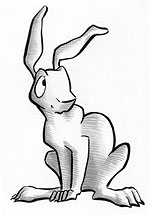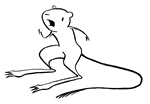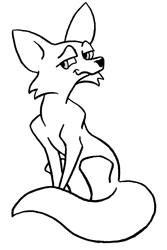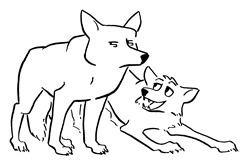Jack is based as closely as I can manage upon actual natural history: the habitats, behaviors, and diets of the animals living in Texas' Big Bend area. The About Jack page has more details on this approach, as well as notes on what passes for my research methods and some sources for further reference.
Below are some of the things I've learned about our main characters.

Jack is a Black-Tailed Jackrabbit (Lepus californicus).
I have started making expanded bios for the characters with new portrait drawings.

Mel is a Kangaroo Rat (Dipodomys species), and they are amazing little things. A lot of desert mammals (jackrabbits included) can survive without water by making use of the moisture in their food, but kangaroo rats go all out. They can easily go their entire lives without taking a drink. They conserve moisture by staying sealed up in their burrows during the day, and are adapted for extreme water-efficiency (they use ALL the moisture in their diet, not even releasing it in their waste).
They're also acrobatic jumpers. They can leap many times their height, and their long tails serve as ballast so they can change direction in mid-jump and zig-zag around to avoid predators (of which there are many, though the one who loves them the most is probably the kit fox).
Mel is kind of a cheat, though, in the authenticity department. There are lots of species of kangaroo rat in the area, but the one with the best story-telling possibilities turns out to be the Bannertail Kangaroo Rat (Dipodomys spectabilis), which occurs near where I live, but not in the desert scrub at the feet of the Chisos Mountains in Big Bend NP, where the story takes place.
But I gave Mel all the behaviors of a Bannertail anyway. One example is in Episode 20, where Mel and Syd identify each other from their individual foot-drum signals (a trait only Bannertails seem to have among west Texas kangaroo rats). There are other specialized behaviors, but they won't really come into play until we get into Part Two.

The most obvious characteristics of the Kit Fox (Vulpes velox) are her small size and her large ears. Kit foxes are the smallest American foxes, about as big as a sizeable house cat (or, say, a jackrabbit). They are almost totally nocturnal, and they rely on hearing as much as eyesight to locate prey (as well as dangers to themselves).
They do apparently eat quite a few jackrabbits - no mean feat, I imagine, since they're about the same size - but most sources indicate that their preferred food is the kangaroo rat. So much so, in fact, that the presence or absence of kangaroo rats plays a big role in determining the range of the kit fox.

Claude and Jake are our Coyote (Canis latrans) representatives.Some of the most well-known of desert mammals, coyotes are also among the most adaptable and intelligent. Predator control initiatives that (along with general habitat pressures) have taken a huge toll on other large predators have only resulted in an increase in range for the coyote, as they move into new and ever more varied ecological niches to survive. Coyotes will eat anything readily available: small mammals, carrion, birds, lizards, insects, fruits and berries, garbage, even old shoes or bits of leather.
At the same time they are very clever. There are many reports of individuals displaying ingenious hunting methods or avoiding well-hidden traps. They hunt or scavenge their territories alone or occasionally in pairs or small family groups (young coyotes often hunt with their parents until they are old enough to move into their own territory. In this Claude and Jake are a bit of a stretch: let's say Claude is Jake's uncle and leave it at that). There is also a larger social structure carried through scent (the "fire hydrants" of the desert, you might say) and the famous coyote howl, and there are also reports of coyotes gathering playfully in larger groups.